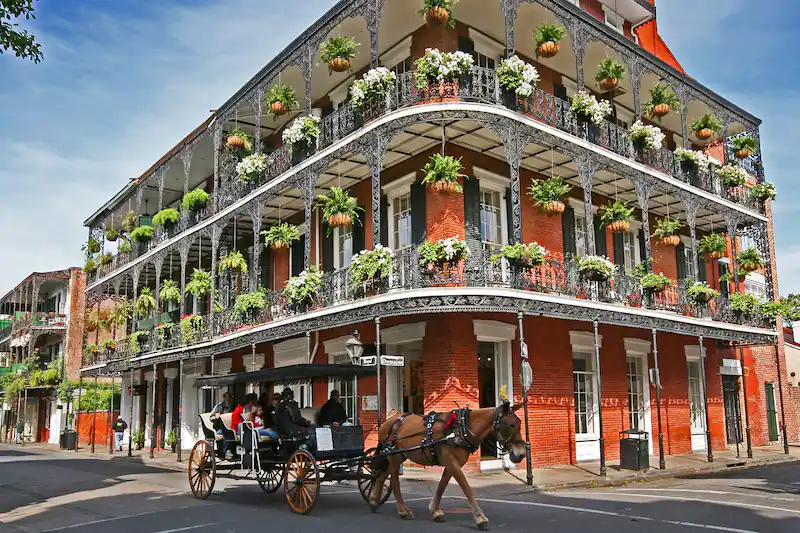Hey there! Join us in the heart of New Orleans, where the mighty Mississippi River does its winding dance, cradling a spot that’s basically a living masterpiece – the French Quarter. Forget just bricks and cobblestones; we’re talking about a neighborhood that’s alive, breathing in the vibes of days long gone. Let’s wander these twisty streets together, soak in the feelings, and dig into the stories stitched into the very fabric of the Vieux Carré. It’s not your average tale; it’s a story that hugs the city’s rhythm, crafting a history symphony that vibes with every heartbeat.
Embracing the Cradle of Culture
Picture it – the year 1718. The French, with a vision in their hearts, birthed the French Quarter on the banks of the Mississippi. The Quarter wasn’t just a settlement; it was an embodiment of dreams, strategically perched on elevated ground amid the swampy embrace of nature. A dance of destiny unfolded as it became a lifeline for ships, a heartbeat echoing through the river’s pulse.
A Flamenco of Flames and Resilience
But destiny is a fickle partner, and in 1788, the Quarter faced a trial by fire – literally. Flames engulfed the mostly wooden structures, leaving destruction in their wake. Not once, but twice, in 1788 and 1794, the Quarter rose from the ashes, transforming its very essence. It was as if the Quarter itself had learned to dance through the flames, emerging with a resilience that would define its character.
The Spanish Waltz: Flamboyance Amidst Adversity
In 1762, the Quarter found itself twirling in the arms of Spain. A new chapter began, marked by prosperity and a fusion of cultures. The fires prompted Spanish authorities to infuse protective measures – plaster-clad walls, fire-retardant roofs, and the elegant dance of mass-produced cast iron. The Quarter wore its scars as a badge of honor, emerging not just French but with a distinct Spanish flair.
Ballet of Architectural Marvels
The late 18th century witnessed the rise of architectural titans – the Cabildo, Presbytere, and the timeless St. Louis Cathedral. These structures weren’t mere buildings; they were the notes in a symphony of prosperity, echoing through the Quarter’s alleys. Rows of mansions, like those on Royal Street, spoke of opulence and affluence, each brick a testament to the dreams woven into the Quarter’s fabric.
A Waltz Beyond the Quarter’s Borders
As the city kept growing, it brought in new neighborhoods – places like Faubourg St. Mary, Faubourg Marigny, and Faubourg Tremé. It felt like the city was getting more lively, like a big family. Streets such as Canal Street and Esplanade Avenue were like the heartbeat, giving lots of life and energy to the middle of the city. It felt like the city was becoming a lively community. Streets such as Canal Street and Esplanade Avenue were like the lifeblood, giving lots of energy to the heart of the city. The Quarter wasn’t just contained within its historic boundaries; it waltzed with the rhythm of an ever-growing metropolis.
The Tango of Challenges and Changes
The 20th century brought challenges – a decline in grandeur, as houses turned into rooming spaces and warehouses. Railroad tracks and industries embraced the riverfront, altering the Quarter’s silhouette. The Quarter stood at a crossroads, torn between demolition and preservation, a city in search of its identity.
Symphony of Preservation
In the 1910s and ’20s, a crescendo of voices rose, calling for the protection of the Quarter’s soul. Tourism became the melody that intertwined with preservation efforts. The Louisiana Constitution amendment in 1936 became the anthem, birthing the Vieux Carre Commission. The Quarter wasn’t just a historic relic; it was a living testament to the tenacity of a community.
Modern Refrain: Hotels, Preservation, and Change
Hotels, rising like crescendos, became part of the Quarter’s skyline. However, in the 1970s, a pause was struck – a moment where preservation halted the encroachment of progress. Today, the Quarter stands as a blend of past and present, a living mural of single-family abodes and cultural diversity.
A Jazzed-Up Nightlife
Once, the Quarter’s nightlife was a scattered melody. The Tango Belt around Iberville Street danced with lively clubs and theaters. Prohibition brought change, shifting the spotlight to Bourbon Street. After World War II, Bourbon Street became a global sensation, a vibrant nocturnal composition that resonates through the ages.
At the end of the day, the French Quarter is more than just impressive buildings; it’s a beautiful poem penned with the ink of resilience, twirling to the beat of history. As we stroll down its cobblestone streets, catching the whispers of its rich walls, let’s keep in mind – the French Quarter isn’t just a place you go to; it’s a living heart, thumping in tune with the soul of New Orleans.
Read also : Waterside Wonders: A Journey through the French Quarter on Lake Conroe
